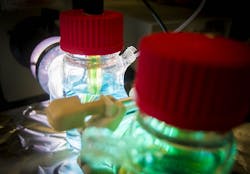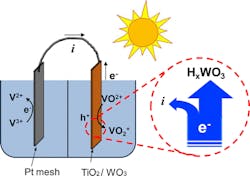Solar-Power Battery Continues Charging Without Sunlight
A newly developed vanadium flow cell battery continues to charge even when the sun goes down or becomes momentarily covered by a cloud. Recently unveiled by a research team from the University of Texas at Arlington, the battery stores electrons in its anode, which potentially turns it into a reliable and consistent source of electricity, despite the intermittency of its renewable energy source.
The National Science Foundation awarded a $400,000 grant to Dong Liu and his team in 2013 to design a battery that would make solar power a more viable resource for large-scale power grids. The design (shown below) uses a tungsten trioxide/titanium dioxide (WO3/TiO2) photo-electrode immersed in an all-vanadium photo-electrochemical cell (PEC), shown in blue. This electrode connects to a receiving platinum (Pt) electrode that’s also submerged in the vanadium PEC via a conductive wire.
The sun provides the activation energy for a redox (reduction oxidation) reaction between the photo-electrode and the vanadium, reducing the WO3 to HxWO3 (hydrogen tungsten bronze) in the electrode. Through several tests, the team showed that the HxWO3 is responsible for storing electrons in the electrode while releasing electrons that travel through the wire to the Pt electrode. The Pt electrode releases the electrons in the vanadium electrolyte, so that the battery charges when exposed to sunlight.
Without sunlight, the HxWO3 continues to release the stored electrons to generate an electric current over the bridge to the Pt electrode. The Pt electrode releases electrons into the vanadium electrolyte, charging the battery in the dark.
The university team is now working on a larger prototype, for more charge-storage capacity.
For more information, check out the paper, "Reversible Electron Storage in an All-Vanadium Photoelectrochemical Storage Cell: Synergy between Vanadium Redox and Hybrid Photocatalyst", which was published in the American Chemical Society journal ACS Catalysis.
About the Author
Leah Scully
Associate Content Producer
Leah Scully is a graduate of The College of New Jersey. She has a BS degree in Biomedical Engineering with a mechanical specialization. Leah is responsible for Machine Design’s news items that cover industry trends, research, and applied science and engineering, along with product galleries. Visit her on Facebook, or view her profile on LinkedIn.

